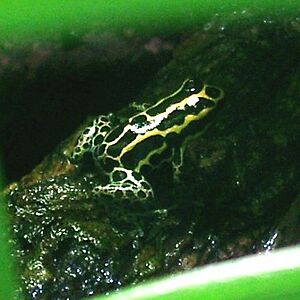Ranitomeya facts for kids
Quick facts for kids Ranitomeya |
|
|---|---|
 |
|
| R. ventrimaculata | |
| Scientific classification |
|
| Kingdom: | Animalia |
| Phylum: | Chordata |
| Class: | Amphibia |
| Order: | Anura |
| Family: | Dendrobatidae |
| Subfamily: | Dendrobatinae |
| Genus: | Ranitomeya Bauer, 1986 |
| Diversity | |
| 16 species (see text) | |
Ranitomeya is a group of tiny, colorful dart poison frogs. You can find them in places like Panama and South America, stretching down to Peru and Brazil. They might even live in Bolivia! These frogs are known for their bright colors, which often warn predators that they are poisonous.
Contents
What are Ranitomeya Frogs?
Ranitomeya frogs are a special kind of poison dart frog. They are usually quite small, often less than an inch long. Many of them have more than two bright colors on their bodies. If you look at them closely, they might even seem to sparkle!
How Ranitomeya Frogs Got Their Name
Scientists often group animals based on how they are related. In 2006, a group of scientists led by Grant changed how many poison dart frogs were classified. They moved many species that used to be in other groups, like Dendrobates and Phyllobates, into the Ranitomeya group.
Later, in 2011, other scientists noticed that some Ranitomeya frogs were different enough to be in their own group. They created a new group called Andinobates for 12 of these species.
Where Do They Live?
Ranitomeya frogs are found all over the Amazon basin, which is a huge rainforest area. On the other hand, Andinobates frogs live mainly in the northern Andes mountains, going all the way up to Central America.
Amazing Features of Ranitomeya Frogs
These small frogs are truly amazing! They are usually no bigger than 21 millimeters (about 0.8 inches) from their nose to their bottom.
Bright Colors and Patterns
Ranitomeya frogs are famous for their amazing colors. Their backs are often bright yellow, red, or green. These colors can be solid, or they can have cool stripes or dots. Even their throats have special colors, usually yellow, orange, or red. Their skin is smooth or a little bumpy.
Unique Froggy Habits
Their heads are narrower than their bodies. They have special pads on their fingers and toes, which help them climb. The pads on their fingers are quite large.
Some Ranitomeya species have very interesting ways of raising their young. For example, the R. variabilis carries its tadpoles on its back. These frogs also sometimes show "cannibalistic behavior," which means the tadpoles might eat other tadpoles if food is scarce. This helps the strongest tadpoles survive.
Threats to Ranitomeya Frogs
Sadly, many Ranitomeya species are facing big problems.
Losing Their Homes
One major threat is habitat loss. This happens when the places where they live, like rainforests, are destroyed for farming, logging, or building. When their homes disappear, these frogs have nowhere to live or find food.
Pet Trade Dangers
Another big problem is collection for the pet trade. Some people want these beautiful frogs as pets. When too many frogs are taken from the wild, it can make it hard for the remaining frogs to reproduce and keep their populations healthy. This can put them in danger of disappearing forever.
Species of Ranitomeya
Currently, there are 16 recognized species in the Ranitomeya group. Each one is unique and beautiful!
- Ranitomeya amazonica is found in parts of Peru, Colombia, Brazil, Venezuela, Guyana, and French Guiana.
- Ranitomeya imitator lives in the Loreto Region of Peru. This frog is famous for mimicking other poisonous frogs!
- Ranitomeya reticulata is found in eastern Peru.
- Ranitomeya sirensis lives in the Amazon rainforests of Peru and Ecuador.
- Ranitomeya ventrimaculata is found in Brazil, Colombia, Ecuador, French Guiana, and Peru.
Images for kids











